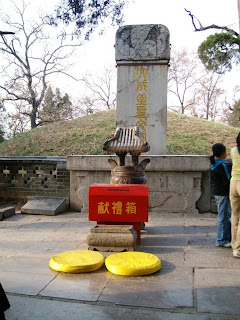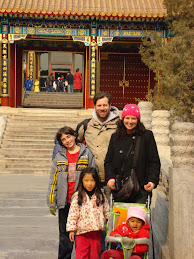To learn, and then have occasion to practice what you have learned-
is this not satisfying?
To have friends arrive from afar-
is this not a joy?
To be patient even when others do not understand-
is this not the mark of a gentleman?
Confucius, Analects 1.1
On Saturday during my stay in Jinan, the Institute of Politics provided a driver for the two hour trip to Qufu [pronounced something like 'chuFOO']. The Philosophy Department gave me a student, "Dominik" [Chinese name unknown], to accompany me. I should say 'us' because my fellow Fulbrighter, Nancy, also accompanied the group.
Qufu is the birthplace and ancestral homeland of 孔子, pronounced 'Kongzi', which means literally "Master Kong". Westerners know him as 'Confucius' [a Latin name given by Jesuits during the Ming Dynasty]. Kongzi was born in Qufu in 551 BC and died there in 479 BC. Kong is a very popular family name in China.
Below is Dacheng Hall, on the spot where Kongzi would teach his disciples. The actual structure dates from the Ming Dynasty (2000 years after Kongzi).

Through the many gates and platforms one arrives at the ceremonial hall, in which you can find a very large statue of Kongzi with robes and beard, etc. It was here that all the emperors of China would come to pay their respects, and make their sacrifices to the great sage.

"The Master said, 'I transmit rather than innovate. I trust in and love the ancient ways.'"
Confucius, Analects, 7.1
Because Kongzi's philosophy became the state ideology, and because he was quite the traditionalist, at various points in Chinese history his philosophy and his ideas came under attack.
Below was a sign that we found in one of the rear building in the Confucian Temple complex. It was behind a door that was open (so that it was not visible unless you went behind the open door - if you follow that).

It is hard to interpret but a consensus of a few students thought that it was an attack on Kongzi which rallies scholars to smash the old ways - likely from the 'Cultural Revolution'. Certainly the Red Guards came into the Confucian Temple, smashed much of the statuary and destroyed much of the old artifacts. But now they are gone, and Kongzi is still around. Tradition 1, Radicals 0.
After we left the temple area, we walked through the Confucian Mansion. Because Confucius, Kongzi, was so important all the members of the Kong family received special state privileges. I am unclear on the full extent of these, but one was that they could live in the Mansion. I don't know how they decided which descendants could live here, but it was a fairly large complex. It was a very traditional Chinese house with various different 'wings' and sections that would accommodate a large extended family.

Above you see a typical bedroom. There were various sitting rooms, as well as a wedding room in which the bride and groom would ascend to the seats of their parents to receive their blessings before heading to a staircase that leads to the second floor ...

The shot above seemed like an interesting view of the tower roughly in the middle of the complex.
After the Mansion we only had time for a quick trip through the Kong family cemetery. Another family privilege is that any descendant of Kongzi can be buried in the family plot - which is huge. Members of the Kong family have been buried here for 2500 years, and they still are today.

The shot above is the grave and marker of one of the later descendants who wrote a famous play called "Charity". As you can imagine, not many people in China are buried anymore. If you can't imagine that, then you haven't spent much time in China. There would just be no place to bury so many people. But if you are in the Kong family, ... you have special privileges.

Throughout the grounds (which we took at fairly high speed in a little tram) a wide variety of statuary could be seen. Unfortunately, I did not have the time to stop and take more interesting pictures.
Finally, we arrived at the section of the cemetery grounds where Kongzi was buried. The long walk toward the area was guarded by a variety of pairs of animals, and finally these two rather impressive generals.

Finally, we came to the relatively simple grave itself. You can see the large marker and the mound under which the old philosopher rests.

The pads and items are for people who come to light incense, or to bow three times, or to pay their respects in whatever way people do.
Below you see that there are two markers. I am not sure why. You can see that the markers, especially the first one, is put back together after the Red Guards smashed it. This is the case with everything in China. Whenever you go into a temple of any sort, you'll see the statuary bisected and put together again - and you know why.

Below is a hut, built in the Ming Dynasty, to commemorate the vigilance of Kongzi's disciples. After the old sage died, his followers stayed on this spot for three years as a mark of reverence. But one of the disciples, a merchant, stayed for another three years as a mark of special respect.

And here you see the younger, not famous, philosopher beside the grave of the old, famous philosopher. [Note my Canisius hoodie. It says "Philosophy" on the back!]

Ran Qiu said, "It is not that I do not delight in your Way, Master, it is simply that my strength is insufficient."
The Master said, "Someone whose strength is genuinely insufficient collapses somewhere along the Way. As for you, you deliberately draw the line."
Confucius, Analects, 6.12





No comments:
Post a Comment